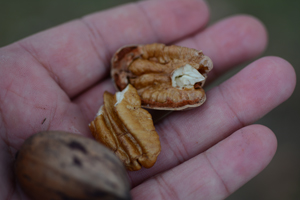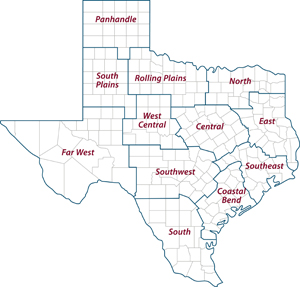Texas Crop and Weather Report
by Adam Russell
An above-average production year for pecan growers could take a hit due to continued wet weather that has delayed harvests and hurt quality, according to a Texas A&M AgriLife Extension Service expert.
Dr. Larry Stein, AgriLife Extension horticulturist, Uvalde, said the Texas pecan crop looked to be above average, but producers are facing late-season challenges due to excessive and continuous rain events.
“We’ve just had too much rain at the end of the season,” he said. “Producers are dealing with a list of problems that hindered quality and caused losses during what looked to be a really good production year.”
Stein said rains have caused some nuts to sprout and soaked opened nuts still in their shucks, which greatly reduces kernel quality. Nuts that sit too long in soaked shucks can also become susceptible to secondary fungal diseases.
Wet conditions are also preventing farmers from harvesting pecans to minimize damages from weather, he said. Pecans are sitting in water and on rain-soaked ground, where quality deteriorates or squirrels, deer, hogs, turkeys, racoons and crows eat them.
Overflowing creeks and rivers have swept pecans downstream, Stein said.
“There are good crops of pecans out there,” he said. “It’s a bigger crop than normal, but the jury is still out on quality. There is some good quality, but also some iffy situations where producers just need to get their pecans in, and moisture slows the process.”
The silver lining from the late-season rains is that pecan trees will be set up nicely for the 2019 growing season, he said. Trees are typically stressed going into winter, especially after a summer of drought.
“The rains filled out the crop and left food reserves, what they need to fill the nut kernels, because of favorable growing conditions,” he said. “You have healthy leaves making food for next year’s crop, and the longer those leaves hang on into the fall, the more likely they are to have a good crop.”
The news is good with a bit of uncertainty when it comes to the domestic and international pecan market, Stein said.
Stein said there is a lot of interest in pecans and that a federal marketing order for the nut could push it into a new strata of popularity domestically. Similar orders have pushed marketing campaigns for almonds and walnuts with great success.
“The marketing order means more research and marketing campaigns devoted to pecans,” he said. “It translates into prominence.”
But the ongoing trade dispute with China could have an impact on the market, though Stein said the federal government has made assurances it would look for ways to mitigate any losses
Over the past decade, pecans have become an increasingly popular commodity among the Chinese.
“We don’t expect the price to dip drastically, but the Chinese market for pecans has become significant in the past three years,” he said. “That has helped keep the price up. We’ll just have to see how everything shakes out — so to speak.”
AgriLife Extension district reporters compiled the following summaries:
CENTRAL: Cotton growers tried to harvest some cotton but got rained out. Many acres of forage remained unharvested due to wet conditions. Clear weather was in the forecast as producers hoped to harvest hay, cotton, peanuts and pecans, but wet conditions continued. Few producers had minimal acres of wheat and oats planted so far. The cotton stalk destruction deadline was extended for two weeks. Cattle remained in fair body condition as producers fed hay. Most counties reported surplus soil moisture. Overall crop, rangeland and pasture conditions were good in nearly all counties.
ROLLING PLAINS: Weather conditions were very pleasant with cooler nighttime temperatures around the 40-degree mark and 70 degrees during the day. Winter wheat looked very promising except for the acres under water or yet to be planted. Cotton producers began to strip cotton fields. Other producers were beginning to defoliate while some wait for the killing freeze. Pastures and rangeland benefited from recent moisture, and winter forages emerged with plenty of moisture to produce nourishment for livestock. Livestock were in good condition, and supplemental feeding was taking place on a small scale.
COASTAL BEND: Drier conditions allowed some fieldwork to take place, but there were still many saturated areas where producers could not enter fields. The cotton stalk destruction date was extended into mid-November. Some soybeans and most ratoon rice crops were yet to be harvested. Warm-season grass growth slowed due to shorter days and cooler temperatures. Hay fields were maturing, but producers were not yet able to cut hay due to wet fields. Armyworms were still creating challenges. Cattle continued to have plenty of forage and were in good condition. Livestock auctions were reporting big runs. The pecan harvest continued.
EAST: Intermittent rainfall and cool temperatures continued throughout the district and contributed to producers struggles to salvage forages. Harrison County reported cut hay was on the ground for up to 14 days. Producers in Cherokee, Marion, Shelby, Smith and Sabine counties continued to wait for a time to cut, cure and bale the last cutting of hay. Producers in Harrison, Henderson, Houston and Marion counties began seeing growth in winter pastures. Winter pastures in Wood and Upshur counties were planted when rain permitted. Pasture and rangeland conditions were very poor in Harrison and Trinity counties, poor in Marion County, and fair to good in all other counties. Subsoil conditions were at a surplus in Houston, Polk, Shelby and Trinity counties and adequate in all other counties. Topsoil conditions were at a surplus in Houston, Polk, Sabine, Shelby and Trinity counties, while conditions were adequate in all other counties. Cherokee, Houston, and Polk counties reported saturated ground conditions, and Trinity County reported the wettest conditions in the county since nearly three decades. Trinity County reported the Trinity River flood waters were over roads and backed up into low areas. Cherokee and Marion counties reported ponds were full. Marion County producers continued to plant fall gardens. Livestock was reported in fair to good condition in Smith and Wood counties. Houston County reported calf numbers were up and prices were steady per hundredweight. Shelby County had good numbers overall at the sale barn, but cow prices were very low and continued to fall per hundredweight. Calf prices per hundredweight started to slowly dip. Wild pig damage was rampant in Henderson, Smith, Wood and Upshur counties. Wood County reported fly control was prevalent.
SOUTH PLAINS: Subsoil and topsoil moisture levels remained adequate. Some producers were able to return to fields for harvest, but some have not. Producers anticipated accessing fields by late in the upcoming reporting period if conditions stay dry. Cotton was struggling to open due to the wet weather. Pasture, rangeland and winter wheat improved with recent rains. Cattle continued to be in good condition.
PANHANDLE: Temperatures were near to slightly above normal. Soil moisture was adequate. Briscoe County wheat looked good. Cotton fields looked excellent with many fields opening and producers preparing for harvest. Cotton farmers began stripping areas that had dried out, but many were still waiting for fields to dry enough to finish harvest. Late corn harvest continued. Wheat plantings were ongoing, but some producers were waiting on some corn to be harvested so drills could pull in behind combines. Some planted wheat produced excellent stands. Harvest of all summer crops was in full swing. Soybean harvest was complete. Cattle were supplemented on range. Weaning of spring calf herds continued.
NORTH: Temperatures dropped below 60 degrees with nighttime temperatures in the 40s. More rain was received and the ground was saturated. The district received almost 40 inches in the last three months and almost 60 inches for the year. Less than half of the district’s wheat and oat producers had planted, and many may not get their acres in this year. Those lucky enough to get fields planted continued fighting costly battles against fall armyworms. Most had to spray with crop dusters because of muddy conditions. Soaked soil soured planted crops, which were yellowing. Moisture prevented cotton harvest and ground preparation for winter wheat. Remaining cotton and soybeans were a lost cause. Low temperatures put a halt to summer grass growth. Volunteer and planted ryegrass were growing nicely. Ranchers were busy weaning and shipping calves, working in muddy pens and standing water. Calf weights were pretty good considering the conditions since August.
FAR WEST: Temperatures ranged from freezing lows to a high of 86 degrees. Rain averaged half an inch to 1 inch. Hail was reported in the far west part of the district. Standing water was still in some areas. Cotton was harvested, and most winter wheat was planted and emerging nicely. Pasture and rangeland conditions were excellent, but producers continued to feed livestock and wildlife.
WEST CENTRAL: Weather was typical with cool nights and mild days. Up to 1 inch of rain was received which did not allow saturated soils to dry. Wheat planting was still delayed due to muddy conditions. Demand and prices were good for stocker calves at the local auction, but cull cow/bull prices were down somewhat. Stock tanks were full, and livestock were in fair to good condition.
SOUTHEAST: Livestock were in good condition. Remaining cotton continued to deteriorate due to wet conditions. Galveston County experienced torrential rains which resulted in localized flooding. Waller County also received additional rainfall, and the entire county was very wet. Brazos County received severe thunderstorms which produced 1.5-2.5 inches of rain, adding to already wet conditions. In Jefferson County, the rice ratoon crop was being harvested. Drier weather was needed since field conditions were boggy. Hay still needed to be baled, but it was beyond mature. Livestock were in good condition. Rangeland and pasture ratings were excellent to very poor with good ratings being most common. Soil-moisture levels ranged from adequate to surplus with surplus being most common.
SOUTHWEST: Small amounts of rain fell in some counties. Most counties reported mild temperatures and sunshine. Pecan harvest and wheat and oat planting were off to a slow start. Armyworms damaged some pastures. Grasses, pastures and rangeland improved due to recent rains. Livestock and wildlife were in great condition with no supplemental feeding necessary.
SOUTH: All parts of the district reported mild weather and adequate soil moisture. Some areas in the eastern part of the district reported surplus soil moisture. Spotty rain showers were reported in northern parts of the district. Peanuts were being dug, and wheat and oats were being planted. Early planted wheat and oat fields looked good. Cotton harvest was completed. Pasture and rangeland conditions were good to excellent. Some fall armyworm activity was occurring, but at lower levels. Body condition scores on cattle were good, and fall weaning and shipping of calves continued. All watermelons and cantaloupes were harvested, and Coastal Bermuda grass was going dormant. Cotton ginning was very active, and some additional spinach planting activities were reported. Most producers reported stock tanks were full. Field activity was minimal in some wetter areas, with the exception of a few hay producers attempting to harvest. In Starr County, hay baling and buffel grass seed harvest operations resumed. In Hidalgo County, sugarcane, citrus and vegetable harvests continued.







